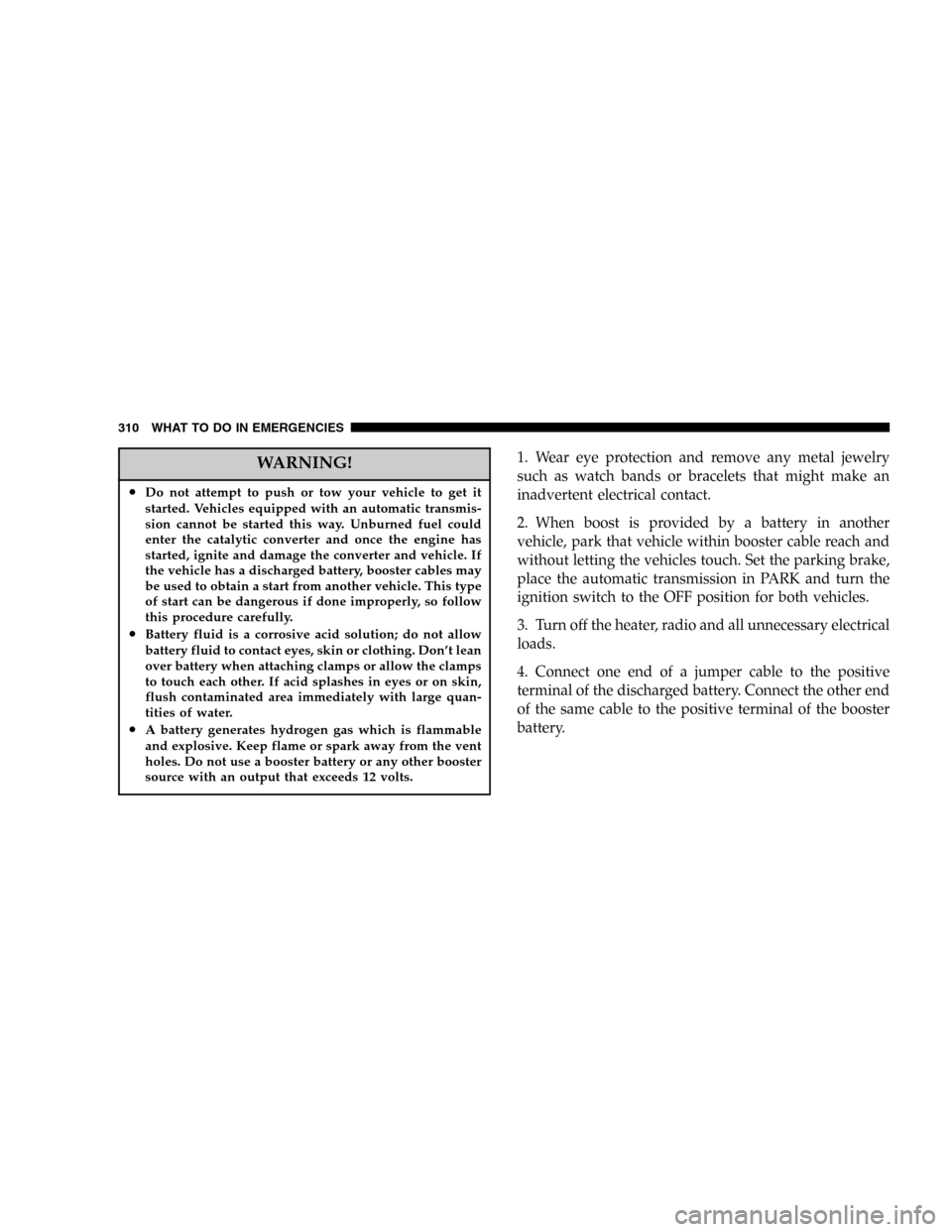Page 310 of 420

WARNING!
•Do not attempt to push or tow your vehicle to get it
started. Vehicles equipped with an automatic transmis-
sion cannot be started this way. Unburned fuel could
enter the catalytic converter and once the engine has
started, ignite and damage the converter and vehicle. If
the vehicle has a discharged battery, booster cables may
be used to obtain a start from another vehicle. This type
of start can be dangerous if done improperly, so follow
this procedure carefully.
•Battery fluid is a corrosive acid solution; do not allow
battery fluid to contact eyes, skin or clothing. Don’t lean
over battery when attaching clamps or allow the clamps
to touch each other. If acid splashes in eyes or on skin,
flush contaminated area immediately with large quan-
tities of water.
•A battery generates hydrogen gas which is flammable
and explosive. Keep flame or spark away from the vent
holes. Do not use a booster battery or any other booster
source with an output that exceeds 12 volts.
1. Wear eye protection and remove any metal jewelry
such as watch bands or bracelets that might make an
inadvertent electrical contact.
2. When boost is provided by a battery in another
vehicle, park that vehicle within booster cable reach and
without letting the vehicles touch. Set the parking brake,
place the automatic transmission in PARK and turn the
ignition switch to the OFF position for both vehicles.
3. Turn off the heater, radio and all unnecessary electrical
loads.
4. Connect one end of a jumper cable to the positive
terminal of the discharged battery. Connect the other end
of the same cable to the positive terminal of the booster
battery.
310 WHAT TO DO IN EMERGENCIES
Page 345 of 420

•Do not overfill the coolant recovery bottle.
•Check coolant freeze point in the radiator and in the
coolant recovery bottle. If antifreeze needs to be
added, contents of coolant recovery bottle must also be
protected against freezing.
•If frequent coolant additions are required, or if the
level in the coolant recovery bottle does not drop when
the engine cools, the cooling system should be pres-
sure tested for leaks.
•Maintain coolant concentration at 50% HOAT engine
coolant (minimum) and distilled water for proper
corrosion protection of your engine which contains
aluminum components.
•Make sure that the radiator and coolant recovery
bottle overflow hoses are not kinked or obstructed.
•Keep the front of the radiator clean. If your vehicle is
equipped with air conditioning, keep the front of the
condenser clean, also.
•Do not change the thermostat for summer or winter
operation. If replacement is ever necessary, install
ONLY the correct type thermostat. Other designs may
result in unsatisfactory coolant performance, poor gas
mileage, and increased emissions.
Hoses And Vacuum/Vapor Harnesses
Inspect surfaces of hoses and nylon tubing for evidence
of heat and mechanical damage. Hard or soft spots,
brittle rubber, cracking, tears, cuts, abrasions, and exces-
sive swelling indicate deterioration of the rubber.
Pay particular attention to those hoses nearest to high
heat sources such as the exhaust manifold. Inspect hose
routing to be sure hoses do not come in contact with any
heat source or moving component which may cause heat
damage or mechanical wear.
MAINTAINING YOUR VEHICLE 345
7
Page 405 of 420

Selection Of Lubricant................349,370
Shifting............................. 253
Special Additives...................... 352
Automatic Transmission................... 349
Adding Fluid......................... 350
Fluid and Filter Changes................. 351
Fluid Change......................... 351
Fluid Level Check...................... 350
Fluid Type........................... 349
Autostick........................135,253,254
Ball Joints............................. 337
Battery............................... 333
Gas Caution.......................... 334
Jump Starting......................... 309
Keyless Transmitter Replacement............ 24
Bearings.............................. 354
Belts, Drive............................ 330
Body Mechanism Lubrication............... 338B-Pillar Location........................ 268
Brake, Parking.......................... 256
Brake System........................258,346
Anti-Lock........................... 258
Fluid Check.......................347,370
Hoses.............................. 346
Warning Light........................ 167
Brakes.............................258,346
Brake/Transmission Interlock............... 251
Break-In Recommendations, New Vehicle........ 67
Bulb Replacement....................... 364
Bulbs, Light............................ 363
Calibration, Compass..................... 180
Capacities, Fluid........................ 368
Caps, Filler
Fuel................................ 290
Oil (Engine).......................328,329
Radiator (Coolant Pressure)............... 343
INDEX 405
10